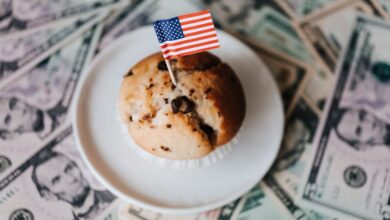Navigating Inflation Expectations: The Psychological Impact and Strategies for Financial Resilience

In today's uncertain economic landscape, inflation expectations play a crucial role in shaping consumer behavior and influencing financial decisions. As individuals and businesses grapple with the psychological impact of anticipated inflation, understanding the nuances behind these expectations becomes essential. Rising costs of living, driven by factors such as wage inflation, supply chain disruptions, and fluctuating energy and food prices, have led to heightened awareness of various inflation metrics like the Consumer Price Index (CPI) and Producer Price Index (PPI).
This article delves into the psychological aspects of inflation expectations, exploring how they affect consumer confidence and spending patterns. We will examine the causes of inflation, including hyperinflation, stagflation, disinflation, and the impact of monetary and fiscal policy on economic stability. Additionally, we will discuss inflation-proof investments and strategies to safeguard your financial future amid rising prices, ensuring that your retirement savings and overall wealth are protected against the tide of inflation trends. Join us as we navigate these complexities and equip you with the knowledge to make informed decisions in a world increasingly shaped by inflation expectations.
- 1. Understanding Inflation Expectations: The Psychological Impact on Consumer Behavior
- 2. The Causes and Types of Inflation: How Anticipated Inflation Shapes Economic Decisions
- 3. Inflation-Proof Investments: Strategies to Safeguard Your Financial Future Amid Rising Prices
1. Understanding Inflation Expectations: The Psychological Impact on Consumer Behavior
Inflation expectations play a crucial role in shaping consumer behavior, influencing how individuals allocate their resources, make purchasing decisions, and plan for the future. Understanding these expectations requires a closer look at the psychological impact they have on various aspects of daily life, particularly in the context of economic fluctuations.
When consumers anticipate rising inflation, they often adjust their spending habits accordingly. For instance, the prospect of increased costs can prompt individuals to buy goods and services sooner rather than later, leading to a surge in demand. This behavior can exacerbate inflationary pressures, creating a self-fulfilling prophecy where the anticipated causes of inflation become reality. Factors such as wage inflation and rising energy prices further contribute to this cycle, as consumers feel the immediate effects on their cost of living.
Central banks and policymakers closely monitor inflation metrics, including the Consumer Price Index (CPI) and Producer Price Index (PPI), to gauge inflation expectations. These metrics help inform monetary policy and fiscal policy decisions aimed at stabilizing the economy. For example, higher interest rates are often implemented to curb inflation, while lower rates may stimulate economic growth during periods of stagflation or disinflation.
Understanding historical inflation trends is vital for consumers, especially when considering inflation-proof investments. Assets such as real estate or digital currencies are often viewed as effective inflation hedging strategies, protecting retirement savings from currency devaluation and the erosion of purchasing power. The psychological aspect of inflation expectations also influences perceptions of economic stability, affecting confidence in financial markets and investment decisions.
Moreover, global inflation trends can impact local economies, leading to supply chain disruptions that result in fluctuating food prices and other essential goods. As consumers navigate these challenges, their expectations of inflation can significantly alter their behavior, from adjusting spending patterns to reconsidering long-term financial goals.
In summary, inflation expectations hold a powerful sway over consumer behavior, driving decisions that can influence broader economic outcomes. By understanding these psychological factors, individuals can better navigate the complexities of inflation, develop effective inflation strategies, and make informed choices in a dynamic economic landscape.
2. The Causes and Types of Inflation: How Anticipated Inflation Shapes Economic Decisions
Inflation is a multifaceted economic phenomenon influenced by various causes and types, each shaping consumer and investor behavior through the lens of inflation expectations. Understanding these dynamics is essential for making informed economic decisions, particularly in a climate where inflation metrics, such as the Consumer Price Index (CPI) and Producer Price Index (PPI), are closely monitored.
One of the primary causes of inflation is monetary policy. When central banks, like the Federal Reserve, adjust interest rates, they influence borrowing costs, spending, and saving behaviors. Lower interest rates can stimulate economic growth by encouraging loans and investments, but if the economy overheats, it may lead to wage inflation and rising costs of living. Conversely, tighter monetary policy can help combat inflation but may risk triggering stagflation, characterized by stagnant economic growth and high unemployment alongside rising prices.
Fiscal policy also plays a crucial role in inflation dynamics. Government spending can contribute to inflation by increasing demand for goods and services. If this demand surpasses supply—especially during times of supply chain disruptions—prices can surge, leading to hyperinflation in extreme cases. Moreover, factors like energy prices and food prices significantly impact inflation rates, as they directly affect the cost of living.
Different types of inflation—such as cost-push inflation and demand-pull inflation—further illustrate how anticipated inflation shapes economic decisions. Cost-push inflation occurs when production costs rise, prompting businesses to pass those costs onto consumers. This scenario often leads to inflation expectations that can influence wage negotiations, as workers seek higher salaries to maintain their purchasing power. On the other hand, demand-pull inflation arises when demand exceeds supply, fostering inflation expectations that can drive consumers to make purchases sooner rather than later, further exacerbating inflation trends.
In today's global economy, inflation expectations are also influenced by factors such as currency devaluation and geopolitical tensions. Investors may seek inflation-proof investments like real estate or digital currencies as a hedge against anticipated inflation, aiming to safeguard their retirement savings and maintain purchasing power. As inflation expectations shape economic decisions, understanding these causes and types of inflation becomes crucial for individuals and policymakers alike, guiding them in developing effective inflation strategies.
Ultimately, recognizing the interplay between inflation expectations and economic behavior is vital for navigating the complexities of the modern financial landscape, particularly as global inflation trends continue to evolve.
3. Inflation-Proof Investments: Strategies to Safeguard Your Financial Future Amid Rising Prices
As inflation continues to rise, understanding how to protect your financial future becomes increasingly important. Inflation-proof investments are strategies designed to safeguard your wealth against the eroding effects of rising prices. With various types of inflation—such as wage inflation and real estate inflation—investors must consider how their choices can mitigate risks associated with inflation expectations.
One effective strategy is to invest in real assets, such as real estate and commodities. Real estate often appreciates in value during inflationary periods, making it a solid choice for retirement savings. Additionally, commodities like precious metals and agricultural products can serve as tangible assets that tend to retain their value when inflation rises, particularly in response to supply chain disruptions or spikes in energy and food prices.
Another approach is to consider inflation-linked bonds, such as Treasury Inflation-Protected Securities (TIPS). These bonds adjust their principal based on inflation metrics like the Consumer Price Index (CPI) and the Producer Price Index (PPI), offering investors a hedge against inflation while providing a steady income stream. This is especially vital during periods of hyperinflation or stagflation, where traditional investment returns might struggle to keep pace with rising costs.
Investors should also explore alternative investments, such as digital currencies, which have gained traction in recent years. While still volatile, cryptocurrencies may offer a hedge against currency devaluation and can provide diversification in a portfolio. Additionally, staying informed about global inflation trends and the monetary and fiscal policies enacted by central banks can help investors make timely decisions that correspond to inflation strategies.
In conclusion, inflation-proof investments are essential in navigating the complexities of inflation and its various causes. By focusing on tangible assets, inflation-linked securities, and alternative investments, individuals can better position themselves to weather the impacts of rising prices while securing their financial future.
In conclusion, understanding inflation expectations is crucial not only for economists but also for consumers trying to navigate the complexities of rising prices. The psychological impact of anticipated inflation can significantly influence consumer behavior, affecting spending and saving decisions. As we explored the various causes of inflation—ranging from supply chain disruptions to energy price fluctuations—it's clear that different types of inflation, such as hyperinflation, stagflation, and disinflation, present unique challenges and opportunities.
Moreover, adopting effective inflation-proof investments can be a powerful strategy to safeguard your financial future amidst evolving economic conditions. With rising costs of living, wage inflation, and shifting inflation metrics like the CPI and PPI, individuals must remain vigilant about their retirement savings and consider diverse inflation strategies. Additionally, understanding global inflation trends and the role of monetary and fiscal policy can further enhance your financial resilience.
As we look ahead, it is essential to stay informed about inflation trends and the decisions made by central banks that can impact interest rates and currency valuation. By recognizing the psychological aspects of inflation expectations and employing inflation hedging tactics—whether through real estate or digital currencies—you can better position yourself to thrive in an unpredictable economic landscape. Ultimately, being proactive in managing your finances in the face of inflation will contribute to sustained economic growth and stability.





